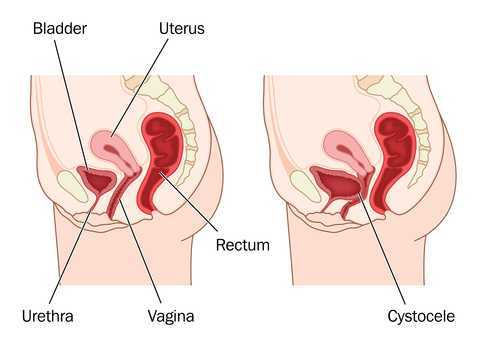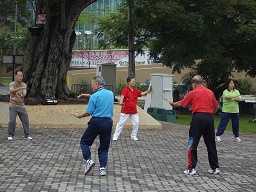
A US study published in the International Society for Sexual Medicine last year reports on the available evidence linking cycling to female sexual dysfunction. In the article, some of the study results are summarized in the left column of the chart below. On the right side of the column, we can consider ideas about how to potentially address these issues.
| Examples of Research Cited |
Ideas for Addressing Potential for Harm |
| dropped handlebar position increases pressure on the perineum and can decrease genital sensation | encourage cyclists to take breaks from dropped position, either by standing up or by moving out of drops temporarily |
| chronic trauma can cause clitoral injury | encourage cyclists to wear appropriately padded clothing, to apply cooling to decrease inflammation, and to use quality shocks or move out of the saddle when going over rough roads/terrain when able |
| saddle loading differs between men and women | women should consider specific fit for bike saddles |
| women have greater anterior pelvic tilt motion | is pelvic motion on bike demonstrating adequate stability of pelvis or is there a lot of extra motion and rocking occurring? |
| lymphatics can be harmed from frequent infections and from groin compression | patients should be instructed in positions of relief from compression and in self-lymphatic drainage |
| pressure in the perineal area is affected by saddle design, shape | female cyclists with concerns about perineal health should work with a therapist or bike expert who is knowledgeable about a variety of products and fit issues |
| unilateral vulvar enlargement can occur from biomechanics factors | therapists should evaluate vulvar area for size, swelling, and evidence of imbalances in the tissues from side to side, and evaluate bike fit and mechanics, encouraging women to create more symmetry of limb use |
| genital sensation is frequently affected in cyclists, indicating dysfunction in pudendal nerve | therapists should evaluate female cyclists for sensory or motor loss, establishing a baseline for re-evaluation |
Because women tend to be more comfortable in an upright position, the authors recommend that a recreational (more upright) versus a competitive (more aerodynamic and forward leaning) position may be helpful for women when appropriate. Although saddles with nose cut-outs and other adaptations such as gel padding in seats are discussed in the article, the authors caution against making any distinct recommendations due to the paucity of literature that is available. The paper concludes that more research is needed, and particularly for considering the varied populations of riders ranging from recreational to racing.
Within a pelvic rehabilitation setting, applying all orthopedic and specific pelvic rehabilitation skills is necessary for women cyclists who present with pelvic dysfunction. Because injury to the perineal area including the pudendal nerve can have negative impact on function such as bowel, bladder, or sexual health, skills in helping a patient heal from compressive or traumatic cycling injuries is very valuable. To learn more about pudendal nerve health and dysfunction, the Institute offers a 2-day course titled Pudendal Neuralgia Assessment, Treatment and Differentials: A Brain/Pain Approach. This course is offered next in Salt Lake City in April, so sign up soon!

A US study published in the International Society for Sexual Medicine last year reports on the available evidence linking cycling to female sexual dysfunction. In the article, some of the study results are summarized in the left column of the chart below. On the right side of the column, we can consider ideas about how to potentially address these issues.
| Examples of Research Cited
|
Ideas for Addressing Potential for Harm |
| dropped handlebar position increases pressure on the perineum and can decrease genital sensation | encourage cyclists to take breaks from dropped position, either by standing up or by moving out of drops temporarily |
| chronic trauma can cause clitoral injury | encourage cyclists to wear appropriately padded clothing, to apply cooling to decrease inflammation, and to use quality shocks or move out of the saddle when going over rough roads/terrain when able |
| saddle loading differs between men and women | women should consider specific fit for bike saddles |
| women have greater anterior pelvic tilt motion | is pelvic motion on bike demonstrating adequate stability of pelvis or is there a lot of extra motion and rocking occurring? |
| lymphatics can be harmed from frequent infections and from groin compression | patients should be instructed in positions of relief from compression and in self-lymphatic drainage |
| pressure in the perineal area is affected by saddle design, shape | female cyclists with concerns about perineal health should work with a therapist or bike expert who is knowledgeable about a variety of products and fit issues |
| unilateral vulvar enlargement can occur from biomechanics factors | therapists should evaluate vulvar area for size, swelling, and evidence of imbalances in the tissues from side to side, and evaluate bike fit and mechanics, encouraging women to create more symmetry of limb use |
| genital sensation is frequently affected in cyclists, indicating dysfunction in pudendal nerve | therapists should evaluate female cyclists for sensory or motor loss, establishing a baseline for re-evaluation |
Because women tend to be more comfortable in an upright position, the authors recommend that a recreational (more upright) versus a competitive (more aerodynamic and forward leaning) position may be helpful for women when appropriate. Although saddles with nose cut-outs and other adaptations such as gel padding in seats are discussed in the article, the authors caution against making any distinct recommendations due to the paucity of literature that is available. The paper concludes that more research is needed, and particularly for considering the varied populations of riders ranging from recreational to racing.
Within a pelvic rehabilitation setting, applying all orthopedic and specific pelvic rehabilitation skills is necessary for women cyclists who present with pelvic dysfunction. Because injury to the perineal area including the pudendal nerve can have negative impact on function such as bowel, bladder, or sexual health, skills in helping a patient heal from compressive or traumatic cycling injuries is very valuable. To learn more about pudendal nerve health and dysfunction, the Institute offers a 2-day course titled Pudendal Neuralgia Assessment, Treatment and Differentials: A Brain/Pain Approach. This course is offered next in Salt Lake City in April, so sign up soon!
This post was written by H&W instructor Ginger Garner. Ginger will be presenting her Hip Labrum Injuries course in Houston in March!

Lots of you have reached out with questions about “best care” practices after hip surgery. There isn’t a whole lot in scientific literature written about rehab, and over many months of fielding questions on my closed HIP LABRAL PHYSIOTHERAPY FB page, I am finally ready to share what Best Care Practices after Hip Labral Surgery may look like.
Today is Post 1 of this series, which will follow me day-by-day, week-by-week, through the highs and lows of my recovery and rehabilitation. Here we go!
First, “What IS Hip Labral Surgery?”
A relatively new term, the surgery is presently called “Hip Preservation.” However I like to call a spade a spade – this surgery is a bona fide hip reconstruction.
This surgery is a major undertaking for surgeon and patient and is constantly charting new territory in surgical techniques and discoveries. A brilliant way to preserve the hip joint, a surgeon is charged with essentially piecing the hip back together and reshaping it to work better than before surgery. It comes with risks AND benefits, many of which I will address in posts to come. It requires serious dedication and a wicked good physical therapist to get you back to fighting shape after surgery. But success begins with choosing a good surgeon who is a specialist in this type of surgery (more on that later).
Not a hip replacement, hip labral surgery rarely ONLY consists of repair of the labrum. Most of the time, a torn hip labrum is an issue secondary to a whole slew of hip disorders that make up a quagmire of highly technical and complex systems that converge during hip reconstruction. Whew, that was a mouthful.
A few of those technical things include hip dysplasia, impingement syndromes (and oh are there lots of different kinds we will be discussing), tendinosis, bursitis, pelvic pain, sexual dysfunction, snapping hip phenomenon (internal and external), anteversion, retroversion, and well, that’s enough to get us started.
Passion for Hip Labral Rehab
Let me tell you that this surgery was everything I thought it was going to be, and a hell (there’s just no other way to put it) of a lot more. I would have LOVED to avoid surgery, and heck, to avoid the injury that led to surgery – because I don’t know a single person who would prefer to gain clinical expertise by actually suffering through the injury or surgery. But alas, adversity is often what makes us better.
As you may guess, I did experience a single traumatic injury – which then proceeded to give birth to a perpetually poorly behaved, havoc-wreaking monster of a chronic condition. The funny thing was before the injury, my area of clinical expertise was ALREADY orthopaedics and women’s health. You can see I was kind of in for a colossal butt-kicking lesson from the universe. Oh the irony…
I did try to prepare myself for the road to recovery though. Read my post on Shutting Down to Move Forward: The Therapist Becomes the Patient.
But trust me, I would rather NOT have gleaned clinical expertise on hip labral and pelvic injury through personal tragedy.
Nonetheless, I knew that my journey from hip reconstructive surgery back to health, was going to help more than just me. I could use it to help so many others who wrestle with that same monster.
But yea, there are a few challenges to recovery:
- I am mother. Of three boys. Ranging in age from 3-9.
- I was/still am trying to finish my doctorate.
- I completed a book chapter for a colleague’s new text on Fostering Creativity in Rehabilitation and a research manuscript during early post-op.
- I had to maintain a full teaching schedule that required walking and stair climbing (which I couldn’t do) and lots of standing (which I also could not do).
- The final straw was, midway through rehab, my oldest son received a special needs diagnosis.
Nevermind having clean laundry and healthy meals to foster healing (and maintain sanity). I mean, a human can only do so much. The point is – I didn’t live tweet or post about my recovery in real time.
The Bright Side
The good side though – is my delay in posting has given me much needed time to reflect on what variables are most critical to the recovery process.
If you are considering hip labral surgery, please read Top Five Must Have Hip Labral Surgery Tips to help you prepare.
Other colleagues I know have released blog series in real time, a chronicle to their injury and recovery. Shelly Prosko and her traumatic Achilles Tendon rupture, is one of those colleagues. Also a physioyogi, I highly recommend Shelly’s series on her recovery. Read here or cut and paste: http://www.gingergarner.com/2014/10/28/medical-therapeutic-yoga-achilles-tendon-rupture-missing-link-rehabilitation/
Now onward and forward, I am (finally) sitting down to write, 5 and a half months AFTER my surgery.
I hope you’ll join me on my journey through Hip Preservation, er, Reconstruction Surgery and that, most of all, you’ll find something that will inspire you to more complete healing and recovery.

An important survey completed in Australia asked if prenatal pelvic floor function and dysfunction relates to postnatal pelvic floor dysfunction (PFD). Interestingly, the authors propose that "…damage to the pelvic floor is probably made before first pregnancy due to congenital intrinsic weakness of pelvic floor structures." Many of the patients involved in the study had dysfunction in more than one domain of pelvic health, with the authors recommending a comprehensive approach to the evaluation of pelvic floor dysfunction.
As part of the large study called the Screening for Pregnancy Endpoints study, or SCOPE, a prospective cohort study called Prevalence and Predictors of Pelvic floor dysfunction in Prenips, or 4P, was also completed. The 4P research (n = 858) contained 2 different studies including a questionnaire-based survey and a detailed clinical assessment. The survey utilized the Australian pelvic floor questionnaire which was administered at 15 weeks gestation and at 1 year postpartum. The Australian questionnaire scores items on domains of urinary dysfunction, fecal dysfunction, pelvic organ prolapse, and sexual dysfunction. When the participants answered the questionnaire the first time, all answers were directed to be answered for symptoms they experienced prior to being pregnant.
The results indicated that at 1 year postpartum, 90% of the women in this study reported pelvic floor dysfunction. Regarding the domains of bladder, bowel, prolapse and sexual symptoms, 71% of the participants reported symptoms from more than 1 of these domains, 31% from 2 domains, 24% from 3 sections of the survey, and 8% from all four sections. Other interesting statistics are as follows:
-of the 73% of participants reporting urinary dysfunction, 67% had these symptoms persisting from the prenatal period
-pre-pregnancy urinary dysfunction symptoms persisted in postpartum in 61% of participants
-for new onset bowel symptoms in the postpartum period, fecal incontinence or obstructed defecation were more likely to occur, while incontinence of gas (flatus) was more likely to occur as persisting symptoms
-prolapse symptoms were reported by 14% of women, with 20% of participants describing symptoms as severe and most common symptoms being vaginal pressure, heaviness, or a sensation of a lump being present
-symptoms of sexual dysfunction such as dyspareunia persisted postnatally in 59% and worsened in 12% compared to prenatal period
In women who delivered vaginally, the risk of pelvic floor dysfunction was increased, yet the authors caution against stating that c-sections are protective against pelvic floor dysfunction. They do theorize based on survey results that c-section may reduce the persisting PFD. Ideally, research such as this can help can assist in creating predictions for postpartum pelvic floor symptoms based on prenatal symptom history. Certainly it may be helpful to be aware of a patient's prenatal symptoms and include any new onset or persisting postpartum symptoms in her rehabilitation. If you are interested in learning more about pelvic floor dysfunction in pregnancy or postpartum, these topics are included in our Pregnancy and Postpartum course series that you can find on our main course page. The Care of the Pregnant Patient is happening in mid-March in Seattle, with a few seats still available! Care of the Postpartum Patient happens next in May in Boston. If you are interested in hosting Peripartum Special Topics, send us an email or give us a call!

When considering rehabilitation of prolapse symptoms, therapists often implement an approach that addresses multiple factors related to pelvic health and function. Rehabilitation of prolapse symptoms may include bladder re-training, pelvic muscle strengthening, bowel health management, trunk and pelvic control strategies, avoidance of potential aggravating maneuvers such as bearing down, and education in management tools such as pessaries. As we have established in earlier posts in this 3-part series, each patient must be evaluated and treated with respect to her complaints and clinical findings. This post highlights a few of the many clinical research studies aimed at determining effectiveness of pelvic rehabilitation for prolapse symptoms.
In recent research, Hagen and colleagues completed a multi-center, randomized trial using parallel treatment groups to assess recovery from prolapse. Women with a stage I-III prolapse of any type confirmed by a physician using the POP-Q system and complaints of prolapse symptoms were the primary inclusion criteria. Women who had previously been treated by surgery for prolapse were excluded. The control group (n = 222) were given a prolapse lifestyle advice leaflet and no pelvic floor muscle training. The lifestyle advice included information about weight loss, constipation, avoidance of heavy lifting, coughing, and high-impact exercise. No information about pelvic floor muscle exercise was included.
The physiotherapy treatment group (n = 2250 received up to 5 individualized sessions of pelvic floor muscle training over 16 weeks. The first appointments were scheduled closer together to allow for proper training in muscle education, with the latter appointments being spread further apart. Rehabilitation began with instruction in pelvic muscle anatomy and function. Exercises were instructed based on results of a pelvic muscle assessment, and exercises were progressed with a goal of up to 10, 10-second holds, and up to 50 quick contractions completed three times per day. Women were also instructed in a pre-contraction of the pelvic floor muscles prior to increases in intra-abdominal pressure. (Electromyography, electrical stimulation, or pressure biofeedback were not allowed among the interventions.)
Outcomes tools included the pelvic organ prolapse symptom score (POP-SS) and several other tools to measure quality of life, level of bother from bowel and bladder symptoms, and a general health survey. Women in the physiotherapy treatment group reported more improvements in prolapse symptoms (POPP-SS). While degree of prolapse was also improved in the intervention group, the authors state that the differences were not significant when compared to the control group. Following are highlights from other research completed in prior years.
In this review of 5 randomized, controlled trials, Kari Bo describes the potential benefits demonstrated in the literature including improved pelvic organ prolapse (POP) stage, symptoms, and pelvic floor muscle morphology. The author summarizes that supervised and more intensive training is more effective than unsupervised training.
In this study the authors conducted 14 weeks of treatment with 7 clinic visits that included pelvic muscle awareness and proprioceptive training, education in home exercise program of strengthening.) Positive outcomes included improved anatomic measurements via POP-Q in anterior and posterior vaginal wall, and decreased prolapse symptoms. The intervention group demonstrated improved muscle strength, endurance, and surface EMG parameters. The study concluded that pelvic floor muscle training is effective in treating prolapse.
Compared with women in the control group, women in the pelvic floor muscle training group in this study demonstrated increased muscle thickness, decreased hiatal area, shortened muscle length, and elevated position of the bladder and rectum. Subjects also demonstrated decreased muscle length at maximum Valsalva, which the researchers indicated as a sign of increased muscle stiffness.
Following a 16 week physiotherapy program, women with stage I or II prolapse demonstrated significant improvement in stage of prolapse in this research. Women in the treatment group were more likely to report subjective improvement when compared to the control group.
The research indicates, although not consistently, that pelvic floor muscle training can improve the level of prolapse or descent in women with various types of prolapse. Many of the studies include not only pelvic muscle strengthening, but pelvic muscle awareness, protection, and training in functional activation to reduce the impact of straining when it does occur. Regardless of improvement in structural measures, women participating in pelvic muscle training consistently report decreased symptoms such as sense of heaviness when standing. In rehabilitation we are always concerned about function, level of bother, and quality of life of our patients. The bottom line appears to be that symptoms rule the day. We can tap into this fact by taking careful histories, by using outcomes tools, and by teaching our patients that over time they may benefit from continued rehabilitation efforts based on their home program. As with any home program, patients may benefit from a reevaluation and modification of a home program.
Although the research addressing perioperative pelvic rehabilitation is emerging, therapy in combination with surgical approaches may also help prepare women for successful management of prolapse symptoms. Evaluation and treatment of prolapse is instructed in the Institute's pelvic floor series, both in the Level 1 and in the Level 2B course. If you are interested in any series courses, please remember to plan ahead, as these courses fill up several months ahead of time! You can find all of our continuing education courses on the website by clicking here.

Tai chi is described in the National Center for Complementary and Integrative Health’s (NCCIH) introduction as a “moving meditation” that originated in China as a martial art. Slow, gentle movements are combined with awareness and breathing. To watch a demonstration of a short form of Tai Chi Chuan click here. The health benefits of Tai Chi have been studied for a variety of conditions, including research funded by the NCCIH. Examples of topics and populations studied in funded research include bone loss in menopause, cancer-related issues such as fatigue, depression, fibromyalgia symptoms, osteoarthritis, cardiovascular function, and other types of arthritis.
A systematic review published last year in Complementary Therapies in Medicine discussed the effects of Tai Chi on quality of life for patients with chronic conditions. Included in the review were 21 articles meeting the criteria of being a randomized, controlled trial, including adults with chronic conditions such as arthritis, asthma, cancer, COPD, diabetes, heart disease, or AIDS, with Tai Chi being the primary intervention that was assessed by an outcome measure. Of the seven studies evaluated for the musculoskeletal system, conditions studied related to post-menopausal osteoporosis, osteoarthritis, rheumatoid arthritis, or fibromyalgia. Quality of life questionnaires were completed by the patients using self-assessment forms.
Although the limitations in the study included poor recording of length of time of Tai Chi sessions, or lack of documentation of home program use of the exercise, Tai Chi was found to be a safe and simple approach that improved self-reported functions, both physiological and psychological. An additional benefit that is pointed out in this research is that Tai Chi requires no equipment or particular facility in which to practice.
Integration of practices such as Tai Chi, yoga, Pilates, or other forms of activity are incorporated any many therapists’ treatment approaches, particularly when the therapist has personal experience or professional training in such approaches. Another way to learn how to incorporate useful skills from these types of approaches is to attend rehabilitation-directed training from someone who is both a practitioner of the approach as well as a therapist. The Institute offers a 2-day continuing education course titled Integrative Techniques for Pelvic Floor and Core Function: Weaving Yoga, Tai Chi, Qigong, Feldenkrais and Conventional Therapies taught by instructors who bring a wealth of knowledge about complementary approaches to rehabilitation. Bill Gallagher and Richard Sabel bring a wealth of experience to this course that is rich in lab practice. They offer their next course at the end of March in Boston. Click here for course details and registration.

Some of our patients will present with sacral or coccygeal pain, and the potential causes of this pain are numerous. One potential cause of sacrococcygeal pain is a Tarlov cyst, which occur when the nerve root sheaths are swollen and fill with cerebrospinal fluid. The condition can be very painful and can affect bowel, bladder, and sexual dysfunction due to the location of the nerves that may be compressed from the swelling. To learn more about the possible causes of Tarlov cyst formation, you can find a lot of information on the tarlovcystfoundation.org site. Symptoms might include low back and buttock pain, neurologic symptoms in the lower extremities, pain with sitting, and swelling over the sacral area. Pelvic dysfunction including bowel or bladder changes, rectal or vaginal pain, or painful intercourse can occur. The pain might worsen with forward flexion due to nerve tension, and pressure changes in cerebrospinal fluid can contribute to headaches or vision disturbances.
Unfortunately, most of our patients present with some or all of the above complaints, so how do we participate in the process of determining when the patient needs to return to a medical provider? In addition, these cysts might be discovered as an “incidental” finding on an imaging study, and the medical provider may complete further tests to determine if the cyst is causing the patient’s symptoms. The most important aspect of screening for dysfunction such as a Tarlov cyst, which can progress to significant neurologic impairment if symptomatic and eft untreated, is keeping track of our patient’s symptom progression and neurologic signs. Getting a baseline lower extremity neurologic screen for every patient with pelvic pain or dysfunction is an critical skill so that we can communicate any significant worsening or lack of progress to the medical provider. Such a lower extremity neurologic scan should include sensation testing, deep tendon reflexes, and signs such as Babinski and clonus tests.
Patients will also present to pelvic rehabilitation after having had a Tarlov cyst repair. Surgeries can include drainage of the cyst followed by use of a fibrin glue to occlude the cyst in hopes of preventing recurrence. The American Association of Neurological Surgeons points out on their website that surgery may not eliminate the patient’s symptoms, and care involving supervised pain management may be appropriate. From a rehabilitation standpoint, these patients may or may not be finding their way to a pelvic rehab practitioner. Is there a provider in your area who may be treating these patients and who is not aware that you have skills to offer? Interventions such as pain management strategies, modalities, movement therapy, manual therapy, treatment directed to neurodynamics, and general wellness education may all play a role in helping patients recover from procedures for Tarlov cysts.
To learn more about treatment of pain in the coccyx area, you can sign up for faculty member Lila Abbate’s Coccyx Pain Evaluation and Treatment continuing education course, with the next opportunity to take the class in Torrance, California, at the end of March.

Many of us in pelvic rehabilitation started out working exclusively with female patients and within the realm of urinary dysfunction. As our caseload broadened and the recognition that a "simple" case of urinary dysfunction was about as common as a "simple" ankle sprain, our education and clinical skills branched out to meet the needs of our patients. Many therapists had to extrapolate what they knew about women's anatomy and pelvic rehabilitation and apply that knowledge to men. (Even despite some therapists' insistence that their caseload should focus on women, the men who were desperate for care would show up anyway!) So what is different about men, and why is there a need to understand not only the common dysfunctions they face, but also how men tend to approach health care?
To begin with, men have significant barriers to healthcare, including lack of a primary caregiver. (Grant et al., 2012) Although men may have greater social privileges than women, that privilege also comes with social pressures to be more dominant, more in control and to be less emotional. (Fleming et al., 2014) These barriers and pressures may make it difficult for a man to seek the healthcare that can improve his state of well-being. Therapists can familiarize themselves with approaches to communication and providing support that fit within the context of the individual patient, allowing him to learn needed strategies while still maintaining a sense of empowerment.
Men also tend to have different pelvic dysfunctions than women. Anatomically, a longer urethra means that men tend to suffer fewer urinary tract infections. Without the physiologic needs for childbirth, men are designed with a smaller pelvis, larger bony attachments for muscles, and decreased rates of prolapse and abdominal wall separation. Men do, however, tend to have higher rates of dysfunctions such as inguinal hernias, and may be more prone to rectal prolapse than rectocele. Prostate cancer, the most common cancer among men, can also lead to significant urinary and sexual dysfunction following surgery or other treatments. As pelvic rehabilitation providers, we want to be best prepared to answer questions about all domains in men's health, whether the concerns relate to bowel, bladder, sexual dysfunction or pain.
The Institute's continuing education course on Male Pelvic Dysfunction is new this year, with all lectures and labs revised. This course has been taught for many years, allowing the instructors to collect feedback about the needs of the therapists who treat men across the country (and around the world!) Because most therapists have not had the opportunity to learn the details of male anatomy that may influence pelvic dysfunction, this course includes anatomy lecture and palpation throughout the two days of training. Topics in the course are designed to cover issues in male continence, sexual function, prostate issues (both benign prostatic hypertrophy (BPH) and post-prostate cancer treatments), and male pelvic pain. Conditions such as epididymitis, scrotal and testicular pain, and Peyronie's are discussed, from the aspects of medical evaluation, rehabilitative evaluation and intervention, and from the available literature.
If you are already treating female patients, your knowledge will serve you well in the Male Pelvic Dysfunction course. If you are completely new to pelvic rehabilitation, this course will cover important basics such as internal (rectal) pelvic muscle assessment and skills for pelvic rehabilitation. The labs and activities have been re-designed to allow both the experienced and the new therapist to feel appropriately challenged regardless of skill level. If this is your year to increase your knowledge (and maybe your caseload) about men in pelvic rehab, you will have opportunities in March in Nashville and Denver in August to take the male course!
References
Fleming, P. J., Lee, J. G., & Dworkin, S. L. (2014). “Real Men Don't”: Constructions of Masculinity and Inadvertent Harm in Public Health Interventions. American Journal of Public Health, 104(6), 1029-1035.
Grant, C. G., Davis, J. L., Rivers, B. M., Rivera-Colón, V., Ramos, R., Antolino, P., . . . Green, B. L. (2012). The men’s health forum: An initiative to address health disparities in the community. Journal of community health, 37(4), 773-780.

Measuring pelvic floor function and dysfunction is an emerging clinical science. Researchers and clinicians including Kari Bo, physiotherapist from Norway, have contributed tremendously to the field of pelvic rehabilitation. In an article by Bo and Sherburn published in the Journal of Physical Therapy, the authors describe methods of evaluating pelvic floor function as being divided into measuring of contraction ability (clinical observation, vaginal palpation, ultrasound, MRI, or electromyography (EMG)), and measuring of strength quantification (manual muscle test via vaginal palpation, manometry, dynamometry, or cones.) The authors state that while each method has their place in rehabilitation, each also has limitations. In addition to understanding the best methods for examining pelvic muscle function, we can also consider the techniques that are most useful in examining pelvic organ prolapse.
In standing, gravity exerts increased force on the tissues of the pelvis and pelvic floor, therefore, prolapse may be more easily and accurately identified in the standing position. Frawley and colleagues have pointed out that because the provocation of prolapse is higher in standing than in sitting for most patients, rehabilitation testing in standing may be more reflective of functional pelvic floor muscle activity. Research has also concluded that digital (using an examining finger) pelvic organ prolapse examination in supine is unreliable. In standing, however, the same article reports that quality of life and symptom impairment do correlate with digital pelvic floor muscle testing.
Although it has been established that physiotherapists can reliably utilize the pelvic organ prolapse quantification (POP-Q) protocol, POP-Q staging and ordinal scale staging (scoring on a 0-4 scale) have been found to be similar in identifying prolapse. This brings us to the question of how to clinically evaluate for pelvic organ prolapse in standing. Therapists use a variety of strategies for assessing a patient in standing, including:
- Ask patient to sit or squat over opening in table (you may or may not have such a table)
- Palpate digitally while patient is in standing position
- Use a mirror on the floor or hold a mirror under the patient's perineum
- Position yourself under the patient while testing
- Have patient sit on a bedside commode with the center piece open
- Ask the patient to stand on a table (consider safety of this option!)
While it may be useful to test patients for prolapse in supine, research points us to the need to also test patients in positions that will reflect the most significant symptoms. Considering the patient's functional needs as well as anatomic variations, this position may be in quadruped, prone, squatting, or standing, and we must figure out how to incorporate these functional positions into our training.

How does pelvic floor muscle function differ in women with symptoms of overactive bladder compared to symptomatic women? A study completed by Knight and colleagues included determining if pelvic floor muscle surface electromyography (EMG) and pelvic floor muscle (PFM) performance were different among these groups. Scores regarding anxiety, life stress, and quality of life were assessed. Symptoms of overactive bladder can include urinary urgency, frequency, nocturia, and leakage of urine. Subjects in this study had "dry" overactive bladder, meaning that the patients did not experience leakage associated with the urgency.
28 women with urinary urges and frequency were age-matched to 28 asymptomatic controls. Participants completed the Beck Anxiety Inventory, Pelvic Floor Distress Inventory, Pelvic Floor Impact Questionnaire, and the Recent Life Changes Questionnaire. Surface EMG was utilized to assess pelvic floor muscle function. Results of the study included that women with urinary urgency and frequency had significantly more anxiety than women in the control group. Surface EMG measures (pathway vaginal sensor was used with self-placement) were not significantly different for ability to contract or relax the PFM. Scores on the PFIQ and the RLCQ were significantly higher for women with overactive bladder. The authors conclude that, although a causative relationship could not be made between overactive bladder and anxiety, there exists a relationship between the two conditions.
Another interesting study which compared interventions of yoga versus mindfulness for women who have symptoms of urinary urge incontinence found that mindfulness-based stress reduction was effective for reducing urinary incontinence episodes whereas yoga was not. This study followed a pilot directed by the same primary investigator which showed similar positives results of mindfulness training on urinary urge incontinence.
What are the clinical questions we may draw from these research reports? Does anxiety cause urinary urgency and frequency, or does urinary urgency and frequency cause anxiety? We all have felt the intense stress of having to empty our bladders and not knowing where the nearest restroom (or freeway exit) is. We also know how the bladder and bowels are affected by stress- how many times did you visit the port-a-potty before that last 5K run? As is the case with many conditions with which our patients present, we may not know if one started the other, and most likely, the combination of issues resulted in dysfunction. Regardless, in our pelvic rehabilitation practices we have the tools to help patients learn about their anatomy, physiology, power in healing, and skills to affect urinary urgency and frequency.
By accepting you will be accessing a service provided by a third-party external to https://hermanwallace.com/







































